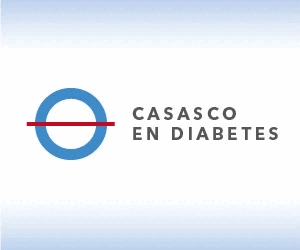Impacto de la cirugía bariátrica en pacientes con obesidad y diabetes mellitus tipo 1
DOI:
https://doi.org/10.47196/diab.v53i3Sup.170Palabras clave:
diabetes mellitus tipo 1, obesidad, cirugía bariátricaResumen
Introducción: la obesidad es un problema médico serio y en crecimiento en los pacientes con diabetes mellitus tipo 1 (DM1). El tratamiento de reemplazo con insulina es la única terapia disponible y los principales efectos adversos asociados son la hipoglucemia y la ganancia de peso. La cirugía bariátrica (CB) mostró mejoría en el control glucémico en los pacientes con DM2 pero se han reportados pocos casos en DM1.
Objetivos: evaluar los cambios en los parámetros metabólicos en pacientes con obesidad y DM1 a quienes se les realizó una CB.
Materiales y métodos: en forma retrospectiva se evaluaron las historias clínicas de siete pacientes con DM1 y obesidad que fueron tratados con CB. Se utilizó el test de Wilcoxon para muestras apareadas a fin de evaluar la diferencia entre los datos pre cirugía y al año de la misma.
Resultados: se evaluaron siete pacientes con DM1. La media de edad fue de 48 años (IQR 45 a 49). La media de índice de masa corporal basal y al año fue 39,6 Kg/m2 (IQR 35 a 42) y 24,9 Kg/m2 (IQR 24,7 a 29,5) respectivamente. La media de hemoglobina glicosilada basal y al año de seguimiento fue de 9,3% (IQR 8,3 a 10,5) y 7,2% (IQR 6,7 a 8,8). La media del requerimiento de insulina antes y después de la CB fue de 110 UI (IQR 70 a 120) y 24 UI (IQR 16 a 30). Todas las diferencias fueron estadísticamente significativas (p<0,05).
Conclusiones: los hallazgos de este estudio alientan a considerar a la CB como una herramienta en los pacientes con DM1 y obesidad con el objetivo de mejorar el control glucémico y el peso corporal.
Citas
Chillarón JJ, Flores Le-Roux JA, Benaiges D, Pedro-Botet J. Type 1 diabetes, metabolic syndrome and cardiovascular risk. Metabolism 2014; 63:181-187.
DCCT Reserch Group. The absence of a glycemic threshold for the development of long-term complications: the perspective of the Diabetes Control and Complications Trial. Diabetes 1996; 45:1289-1298.
Buchwald H, Estok R, Fahrbach K, Banel D, Jensen MD, Pories WJ, Bantle JP, Sledge I. Weight and type 2 diabetes after bariatric surgery: systematic review and meta-analysis. Am J Med 2009; 122 (3): 248-56.
Sibley SD, Palmer JP, Hirsch IB, Brunzell. Visceral obesity, hepatic lipase activity and dyslipidemia in type 1 diabetes. J Clin Endocrinol Metab 2003 Jul; 88(7).
Franck M, Paquot N, Scheen AJ. Influence of body weight on the natural history of and the therapeutic approaches to type 1 diabetes. Rev Med Liege 2012; 67:461-467.
Cohen R. Comment on: should metabolic surgery be offered in morbidly obese patients with type I diabetes? Surg Obes Relat Dis 2015; 11:805-807
Price SA, Gorelik A, Fourlanos S, Colman PG, Wentworth JM. Obesity is associated with retinopathy and macrovascular disease in type 1 diabetes. Obes Res Clin Pract 2014; 8:e178-e182.
De Block CE, De Leeuw IH, Van Gaal LF. Impact of overweight on chronic microvascular complications in type 1 diabetic patients. Diabetes Care 2005; 28:1649-1655
Czupryniac L, Wiszniewski M, Szymansky D. Long term results of gastric bypass surgery in morbidly obese type 1 diabetes patients. Obes Surg 2010; 20:506-8.
Mendez CE, Tanenberg RJ, Pories W. Outcomes of Roux en Y gastric bypass surgery for severely obese patients with type 1 diabetes: a case series report. Diabetes Metab Syndr Obes 2010; 3:281-283.
Brethauer S, Aminian A, Rosental R. Bariatric surgery improves the metabolic profile of morbidly obese patients with type 1 diabetes. Diabetes Care 2014; 37: e51-e52.
Lannoo M, Dillemans B, Van Nieuwenhove Y. Bariatric surgery induces weight loss but does not improve glycemic control in patients with type 1 diabetes. Diabetes Care 2014; 37: e173-e174.
Kirwan JP, Aminian A, Kashyap S. Bariatric surgery in obese patients with type 1 diabetes. Diabetes Care 2016; 39:941-948.
Landau Z, Kowen-Sandbank G, Jakubowicz D. Bariatric surgery in patients with type 1 diabetes: special considerations are warranted. Ther Adv Endocrinol Metab 2019; Vol. 10: 1-8.
Vilarrasa N, Rubio MA, Miñambres I. Long-term outcomes in patients with morbid obesity and type 1 diabetes undergoing bariatric surgery. Obesity Surgery 2017 Apr; 27(4):856-863.
Descargas
Publicado
Cómo citar
Número
Sección
Licencia

Esta obra está bajo una licencia internacional Creative Commons Atribución-NoComercial-SinDerivadas 4.0.
Dirección Nacional de Derecho de Autor, Exp. N° 5.333.129. Instituto Nacional de la Propiedad Industrial, Marca «Revista de la Sociedad Argentina de Diabetes - Asociación Civil» N° de concesión 2.605.405 y N° de disposición 1.404/13.
La Revista de la SAD está licenciada bajo Licencia Creative Commons Atribución – No Comercial – Sin Obra Derivada 4.0 Internacional.
Por otra parte, la Revista SAD permite que los autores mantengan los derechos de autor sin restricciones.





























